Douglas M. Gillard, DC: an Autobiography
How It All Started | An early fix | 1st Strike | 2nd Strike | 3rd Strike | The Botched Microdiscectomy | Medical School | A New Career as a Spine Researcher | The Educator | How's My Sciatica? | My School Is Closing: Now What? | OMG! Hernia Surgery
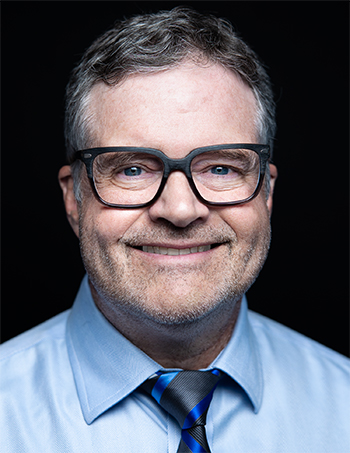
Unfortunately, I am one of the unlucky ones who has been plagued intermittent low back and leg pain for over 40 and 20 years, respectively. Although it was certainly livable for many years, a failed microdiscectomy in 2003, which left my sciatic nerve root damaged and wrapped in scar tissue, has greatly changed my life and made me reinvent myself.
My bad luck, however, is the reader's good fortune, for it has turned me into a "super geek" with regard to spine research. Specifically, I became obsessed with searching the medical literature databases for new breakthroughs in the treatment of chronic back and leg pain, epidural fibrosis, and failed surgery syndrome. When I find important researc , I post it here at ChiroGeek.com and/or on my youtube channel.
How It All Started
I believe my bottom two discs, which are the ones that typically cause trouble, were initially injured about the age of seven-years. Specifically, I was pretending to be Superman and, to my mother's horror, leaped off a 15-foot-high slide, landing feet first in a sandbox. After having the wind knocked out of me, I remember being checked at the hospital, but don't remember having any back pain. The amount of axial load generated during that leap must have been tremendous and probably resulted in disc and vertebral endplate damage-the train of degenerative disc change was put into motion.
When I was about 12 years old, I remember developing low back pain after lifting a snowmobile. This prompted my father to take me to an orthopedic spine surgeon. After reviewing the x-rays, he said that I had "sway back," (i.e., a hyperlordotic lumbar curve) and would always have problems with my back. It is true that hyperlordosis causes biomechanical spinal challenges that are associated with chronic low back pain.
A more memorable incident occurred when I was about 14 years old. I was swinging from the top of our 15-foot-high boathouse out over the lake when the rope broke. I came crashing down into the shallow water in a seated position. This resulted in my first real strong attack of low back pain which took a week or so to to get over.
During my high school years, I would suffer flare-ups of low back pain every three months or so, which would necessitate a day on the couch. I was never offered any treatment and just hold to rest when these flare-ups occurred. Low back pain notwithstanding, I remained very active in high school sports and lettered in football and track & field all four years.
Weight lifting: A Temporary Cure?
After graduating from Mona Shores high school in 1978, I attended Ferris State University on a Track & Field scholarship, and surprisingly, my low back pain completely disappeared a few months after I started heavy training, which included throwing, weight lifting, core strengthening, and circuit training.
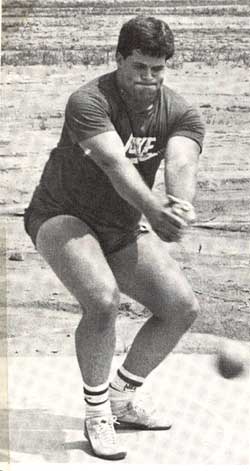
Although I was competitive at the collegiate level in the shot put and discus throw, I really had a gift for throwing the hammer (Hammer Throw Competition) and, in addition to winning several collegiate MVP awards, achieved All-American honors six-times during my four year throwing career at Ferris State. Ultimately, in 2006 I received their highest athletic honor by being inducted into the Ferris State Hall Of Fame. [Gillard Inducted into the Hall Of Fame].
Out of the Snow and In to the Humidity
After graduating from Ferris State, I had a big decision to make: to go into medical school or continue to pursue my dream of becoming an Olympic-level athlete and win a gold medal for the United States.
Against my physician father's approval, I chose the latter and moved to Marietta, Georgia where I increased my level of training (this time without the obstacle of winter) and started graduate school at Life Chiropractic University, which at the time was much less time demanding compared to medical school.
During my time in Georgia, which had a miserable climate for most of the year—it was terribly humid and there were too many gnats for my liking—I rapidly moved up the US Hammer rankings and by 1986 had become one of the best 20 throwers in the Country.
Although a mandatory student x-ray in 1983 demonstrated a 50% loss of disc height at L5/S1 (the train of degeneration was still quietly rolling along), I can't recall a single attack of low back pain during my four years in graduate school, which I attribute to the fact my annular disc tear(s) had not reached the pain-sensitive outer one third of the disc, and I was incredibly strong from all that weight lifting.
To the Land of Sunny California
After graduating from chiropractic college in 1986 with honors (cum laude), I moved to Los Gatos, California in order to work with one of the Olympic hammer coaches, Ed Burke, and, after a six-month internship at a top-notch postsurgical rehab center, I took a job as a associate chiropractor in Gilroy, California.
With guidance from the US Olympic coaches and the help of some top-level international hammer throwers that frequented the area, I moved into the top 10 rankings within a year and qualified for the 1988 Olympic trials, in which I placed (if I remember correctly) 12th.
In 1989, I was one of the hottest young hammer thrower in the land, for I was having training throws over 240 feet in the winter without backing off my training, which would have translated into throws well over 250 feet during the summer season.
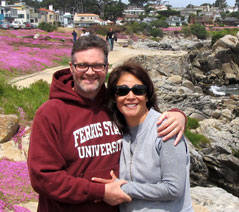
This was one of the happiest time of my life, for not only was I on the path to potentially winning an Olympic medal in the upcoming Olympic Games, I had also met the love of my life, Lydia (figure left), who, God bless her heart, has stuck by me through all these years of hardship and put up with my crazy sports and academic obsessions, as well as my disabilities—she is still the love of my life and the best thing that has ever happened to me.
We still live in Gilroy, CA, in close contact with our 5 children and 11 grandchildren.
The First Strike:The power clean that ended my Olympic dreams
So, things were going fantastic during the winter of 1989 until, for the first time since high school, I suffered a severe attack of low back pain after doing power clean (a weight lifting exercise) triples with weights over 350 pounds (specifically, I slipped on the last rep and hyperextended my low back). The pain was unbearable, and I was not able to even walk for three days.
Although it took me over a month to recover enough to resume my training (which was devastating to a 12-month training program), I was able to salvage part of the 1989 season and managed a personal best of 72.46 meters (237 feet) and a fourth-place finish at the 1989 Olympic Track & Field Championships.
My low-back, however, would never again allow me to accomplish the heavy training and weight lifting that was needed for my continued improvement in the sport; therefore, I sadly called it quits in the fall of 1989.
The Train of Degeneration Keeps a Rolling
After quitting my chiropractic associate job in Gilroy, I turned my full energy towards building a chiropractic practice of my own, and it wasn't long before I was one of the busiest chiropractors in the Bay area. At our peak and with a staff of 15 employees and three associate doctors, we helped thousands of of back and neck pain patients overcome their pain and disability throughout the 1990s and early 2000s.
Because my back was feeling so much better after the elimination of the Olympic-class training routine, I said another sports goal: to become a professional golfer. Although I was able to get down to a 2 tournament-handicap within three years (I had played golf in junior high and high school), again my low back just couldn't take the daily training regimen that I had created; I had to quit the sport after another severe flare-up of back pain in 1995.
In 1995, I sent another goal after attending a Blues Festival in San Francisco with my wife: I wanted to learn to sing and play the guitar, à la Stevie Ray Vaughn. By the late 1990s, that goal was in the officially accomplished, as I had played over 100 gigs in Northern California with my blues band, Dr. Doug and the Blues Creepers. Some new health problems, however, put the Kabbalah on that hobby and I quit. (*I still greatly enjoy singing and playing the blues in my music closet {my wife thinks I'm crazy} and may venture out to form another blues band in the near future.)
The Second Strike: Road bike racing and disc herniations don't mix!
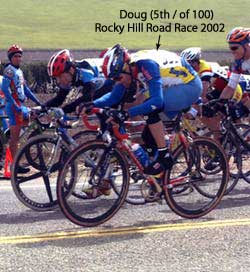
In year 2000, I set my next athletic goal: to become a nationally-ranked road bike racer (à la Lance Armstrong). After hiring a professional coach, I was soon logging hundreds of bike-miles per week and began competing. I was a natural and still had a VO2 over 60 l/min at the age of 40. Their was one piece of advice from my coach that I wish I would have listened to more closely: you can't train hard all the time and needed to lift weights to supplement your road bike training. I figured that since I had lifted weights for over 10 years at a level higher than any of these road bike riders, I didn't need to do it. BIG MISTAKE!
The beginning of the end occurred while doing seated intervals up a 7% grade mountain: I felt something pop and suffered immediate back pain. This time, however, the pain was different, for it was localized in my left and then right sacroiliac joint. So, not being as educated as I am now, I diagnosed myself with having a sprain/strain of the SI joints. *Little did I know was the fact that full thickness annular tears (the precursor to disc herniation) often refer pain to the sacroiliac joints; my diagnosis should have been a full thickness annular tear, which would have drastically changed my training: it would've stopped it completely and immediately.
Alas, notwithstanding the low back pain, I decided to finish my final and favorite race of the year, which was a 7-mile uphill time trial that finished at the top of beautiful Henry Coe State Park—my home turf and favorite training grounds (it was only a few miles from my house).
The Third Strike: ironically, it was a chiropractic treatment that finished me off
As you may have guessed, I suffered a severe flare-up of back pain following that race on 10/20/02, in which I placed 2nd, and I never recovered. Although the pain would settle down after a week or two, the minute I jumped back on my road bike, it would return with a vengeance and force another week or two recovery. This pattern of flare-up and recovery went on for the next few months, until, ironically, a not-so-smart associate doctor of mine finished me off with a chiropractic adjustment.
Specifically, despite my admonition, he tractioned me way too hard, which in turn herniated my L5 disc and probably tethered my left S1 nerve root (an unfixable over-stretch nerve injury). Forty-five minutes after that treatment in January, 2003, I developed horrible left sciatica which has ruined my life, and damn near killed me by being at least part responsible for the development of severe blood clots in that same sciatica-infested leg which progressed into pulmonary emboli, in 2013. Chronic sciatica is truly a horrible curse that no one can completely understand unless they too have lived with the horror.
The Botched Microdiscectomy
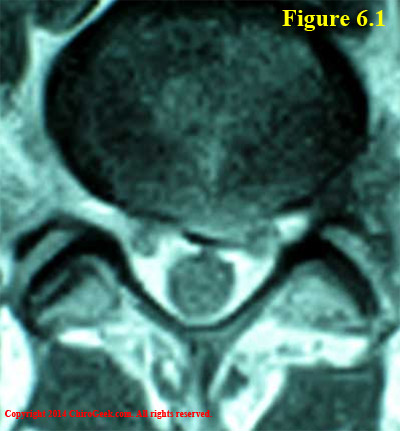
I wish I would've had a resource like this, ChiroGeek.com, available to me before I had my microdiscectomy, because it is well known that small contained disc herniations have a terrible track record with microdiscectomy. Especially, if you've waited for more than 4-6 months (I waited a Year and 1/2). I sure wish my spine surgeon, who must've known this, would've warned me ahead of time. To make things even worse, the surgeon try to, if I remember correctly, do something crazy, which nobody does anymore: he tried to reattach ligamentum flavum. This is probably the reason I have severe scar tissue around the S1 nerve root which has altered my life forever.
The aftermath of the surgery demonstrated MRI-findings of excessive scar tissue around the left S1 root, which I believe was secondary to excessive or rough handling of that root during surgery, and/or trying to reattach ligamentum flavum – which is/was experimental at best. The scar tissue makes it so I don't have any nerve root excursion, which means its really easy to flareup the chronically damaged nerve root.
Medical School: a new adventure
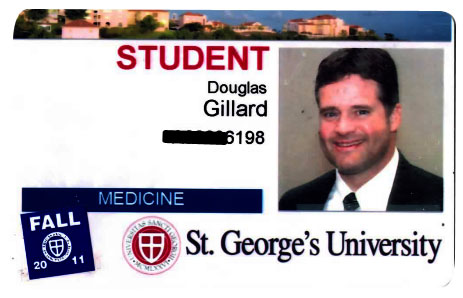
Although it took five years, thanks to mother nature, gentle chiropractic Cox flexion / distraction treatment, exercise and some gently stretching, I recovered to the point that I was no longer in constant pain and could even hike in beautiful mountains of California without flareup. I did have to be careful, however, with hiking up extremely steep grades (because of the lack of nerve root excursion). I also still had the typical limitations of a postsurgical discectomy patient: no heavy lifting; and no repeated bending, twisting, or stooping at the waist.
In fact, I was feeling so good that I decided to take a run at a childhood dream of becoming a medical doctor and getting that Doctorate of Medicine degree.
THIS WAS AN EXTREMELY TOUGH AND CHALLENGING PATHWAY!
First off, I had to go back to college in order to refresh of all my core science classes (i.e., organic chemistry, general chemistry, physics, physiology, anatomy, and molecular biology) and I had to have all A's! I was able to do this by attending several of the local Bay Area colleges while I continue to work as a chiropractor. Even though I did pretty good on the dreaded MCAT, I couldn't get into any medical or Osteopathic school in the United States – probably just too old (47 years old at this time). I did some research on Caribbean medical schools and found that St. George School of Medicine had a very impressive 95% match rate. So I decided to go for and was accepted!
Unfortunately, I soon realized that sciatica is truly "forever" and all that sitting and climbing the hills to get to the classrooms stirred up the "beast" again which made it very difficult physically. I finally got to the point that I just couldn't take the pain and was forced to take a medical leave at the end of 2011.
A New Career: a spine researcher, spine research coordinator, and director of spine research
As it turned out, all that hard work was not in vain, for my blog caught the eye of two spine surgeons almost simultaneously, both of whom wanted me to direct their spine research programs.
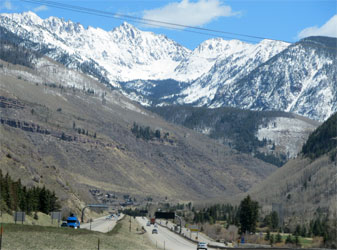
After interviewing and shadowing both doctors, I chose Vail, Colorado, over Melbourne, Florida, and was off on another adventure—much to the chagrin of my loving and ever so patient wife, Lydia.
Specifically, in early 2012, I accepted a job as the Director of Spine Research /Spine Research Coordinator for a prominent orthopedic spine surgeon, and worked under the roof of the prestigious Steadman Philippon Research Institute (The Steadman Philippon Research Institute), in Vail, Colorado.
What an amazing opportunity this was to professionally gather data and then write groundbreaking peer reviewed research papers on the latest innovative techniques in spine surgery and other things related to spine surgery. Not to mention living in Vail Colorado was wonderful! Although I couldn't snow ski or mountain bike ride because of my sciatica, I was able to hike some of the most beautiful trails in the world!
During my two years in Vail, I accomplished a great deal including the design, completion, and publication of two peer-review research investigations, one of which I was the lead author on; the landing of a $54,000 grant for a lumbar brace study that I single-handedly designed and pursued; and the IRB approval (which was not an easy task) of another randomized control trial that I designed. I also learned an awful lot about different data-collection systems and their management, as well as the different methods of collecting long-term follow-up data. I also learned the nuts and bolts of how to build a research program from the ground up.
Unfortunately, the spine unit of the research Institute ran out of funding and was closed; I was out of a job.
What was next?
Once I got back to my California home, I did some freelance work for several spine surgeons around the country, and was published once again in a top-level peer-reviewed journal for paper I designed and wrote that describe details will of a new system for putting morselized bone within the cages used for interbody fusion.
I was just about ready to reopen my chiropractic / chronic pain clinic, when another rare opportunity arose!
The Educator:
In December, 2014, I receive news that I was hired as a full-time anatomy lab instructor for Palmer College of Chiropractic-West. In Addition to the Gross I and Gross II cadaver lab teaching duties, I was also given the Cervical Pathology/Diagnosis class. I was off to the races!
At the time of this update, September, 2022, I am a full professor of Clinical Science and Pathology, as well as the Coordinator of Basic Sciences and past Coordinator of Radiology. Over the years, I teach//have taught many different classes, including the following: cardiovascular and pulmonary pathology; gastrointestinal pathology; urogenital pathology; endocrinology; advanced lumbar differential diagnosis; spinal anatomy; embryology; dermatology; pathology of the eyes, ears, nose, and throat; and the Basic Science Review.
However, all this is coming to an end soon, as our school is closing after 43 years – see below…
How Is My Sciatica & Back Doing?:
It's really been doing quite well. I would say the word is stable. I've learned what my limitations are and try not to go over them. I'll still have a flareup of burning lower limb pain about every other month or so that will last for 2-4 days, but that's about it. The biggest surprise has been that I've learned that by using a cane to help me walk (especially up and down hills), I can go for a long ways (4-5 miles). However, I go very slowly, because most of my walking is done in the woods looking for birds to photograph (I'm big-time into bird photography now – what a challenging and relaxing hobby).If I'm having a bad day with regard to my sciatica, then I just go stake-out an area and wait for the birds to come to me – keep walking to a minimum.
My low back is also doing really well. I still have to be careful of bending, twisting (especially when I'm sitting on the ground watching for birds-- just had 3 week flareup from this no-no), and lifting heavy, but all in all, it too is stable.
For about the last year now, I've been religiously (every morning) doing some stair stretches I that created. I'm planning on making a YouTube video to demonstrate in the near future. I'm convinced that these simple stretches really help keep the flareups of both back and leg pain to a minimum
With regard to my photography, here's a couple of my recent captures:
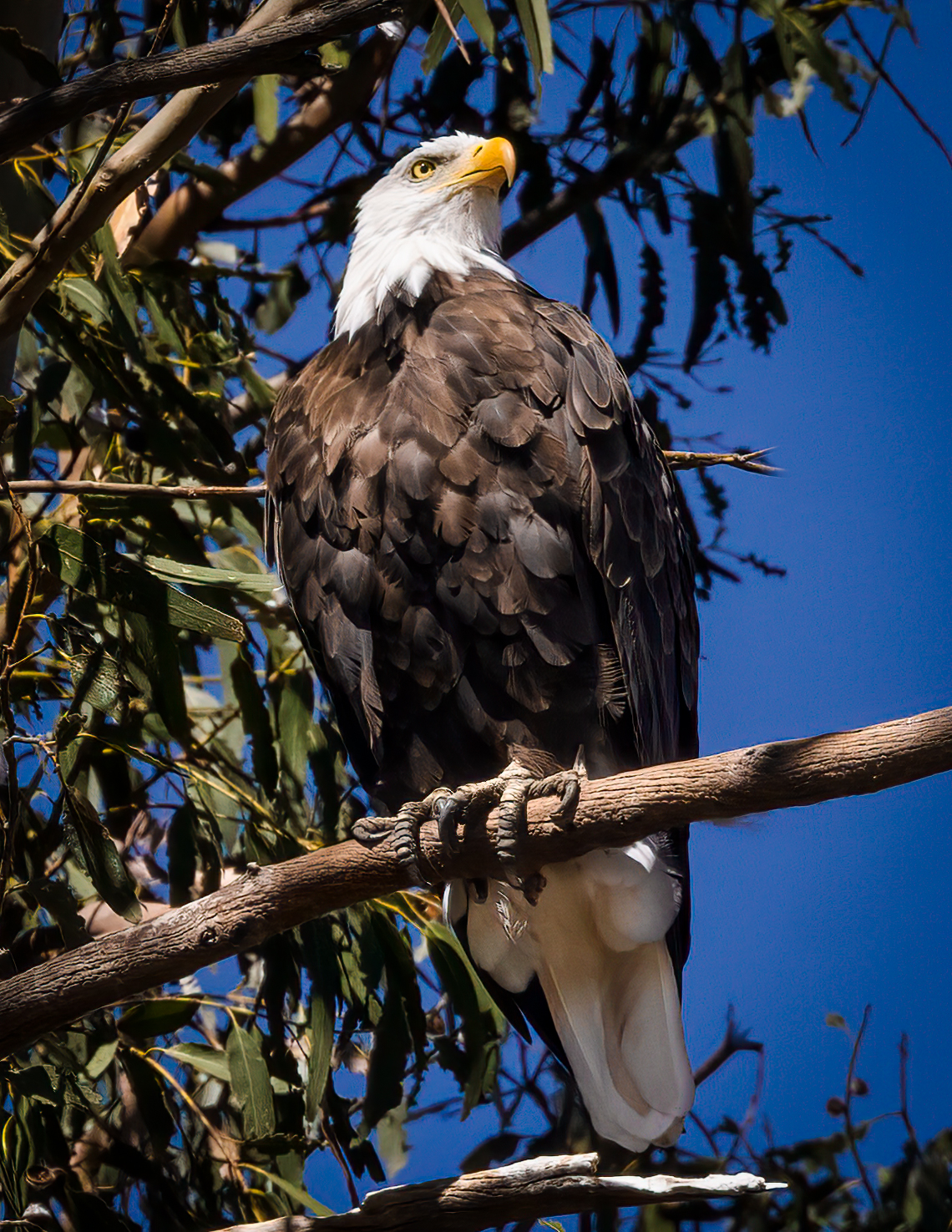
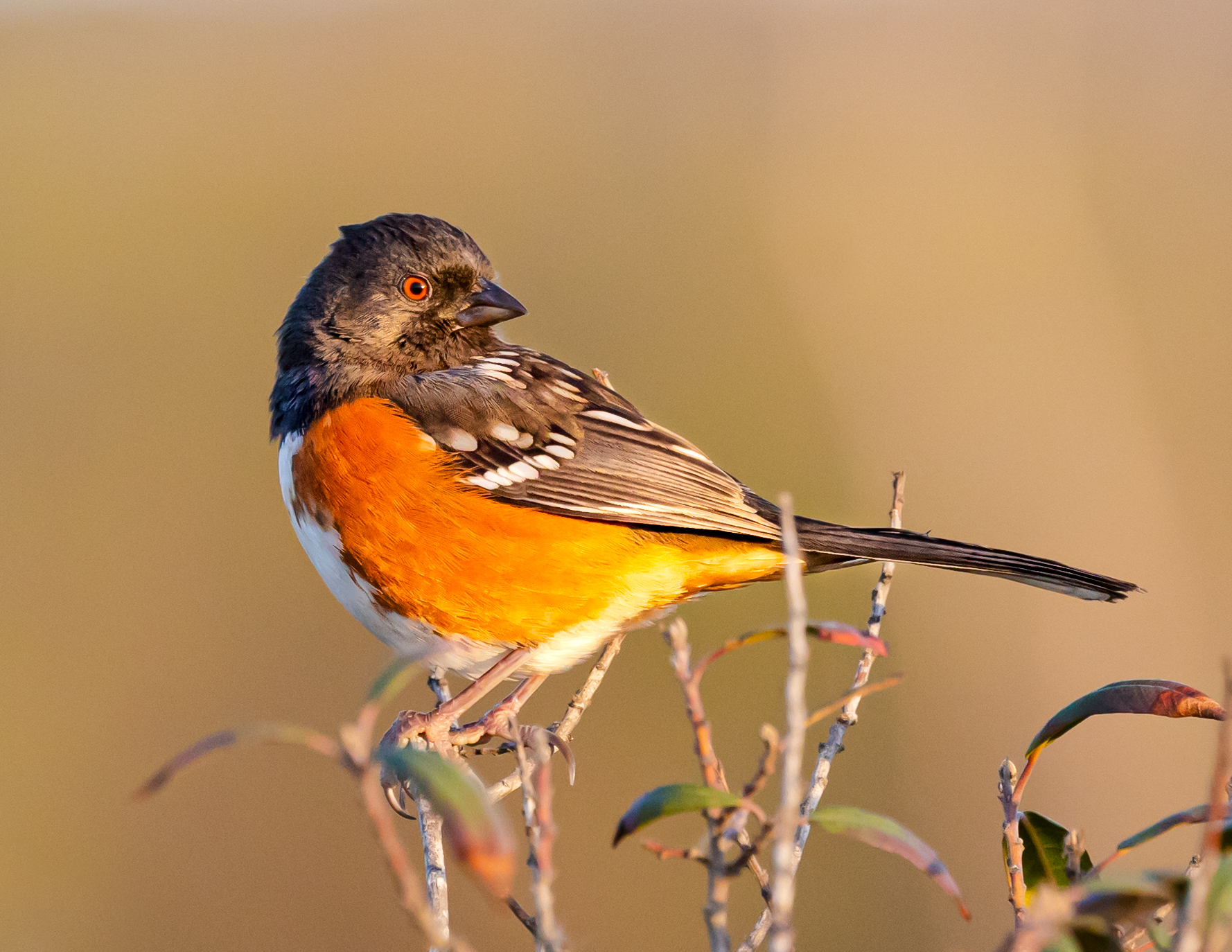
Watch out for the building of a new website which is dedicated to the birds of the bay area. It will be called "BirdGeek.Org".
My School Is Closing: Now What?:
4/22/22: Palmer West is closing!
After 42 years of operation, Palmer West will be closing down completely! The "bomb shell" news was delivered, coldly, by email a couple weeks ago and has left many of us scrambling to find a new teaching job. How incredibly disappointing and confusing, for our campus is packed full of students, so it's not all about money? Our CBA demands that they provide proof of financial hardship, which is the only way they're allowed to close down this nonprofit, but to my understanding this proof has never been given, not even to our administrators. Anyway, that's not my concern anymore – see below
Although I am busier than ever, with regard to my consultation service, I still greatly enjoy teaching and want to continue that, somewhere. I truly believe everything happens for a reason, so we will see what education path the ChiroGeek will head down next :-)
12/13/22: New Job: Life Chiropractic College West
I just finished my first quarter working for Life Chiropractic College West, and boy oh boy, what a wonderful experience it has been, so far. Major culture change too! The entire faculty and staff made me feel right at home and really bent over backwards to do so. It's so nice to be appreciated :-) I'm so grateful that they took me in and are paying me so well (more than I was getting at Palmer)! Pretty hard for 62-year-old to get hired by anybody-- I'm so sincerely grateful!
They hired me as a Professor Basic Science and gave me two lecture classes to start out with: Embryology and Systemic Physiology. Embryology was easy, for I've taught that before; although, this is class three hours, instead of two hours per week (so I have some slides to make still for this class). However, I've never taught physiology before – this is something I've always wanted to get started into, so I had no slides and only got a 1 week notice! It was an incredibly mentally draining quarter with long nights and very little weekend free time, but I did it! Made about a thousand PowerPoint slides and, although I don't have the class nearly where I want it, I made it through :-)!
The other exciting thing is that I'm back in the anatomy/cadaver lab, which is something I really missed (at Palmer, I was teaching five lecture classes and no more anatomy labs). Specifically, I'm teaching Regional 2 Gross anatomy, Regional 3 gross anatomy, and, (my favorite) Spinal Anatomy. Unlike my previous employer, we have many cadavers to teach the students with, which is a huge learning plus--even a dedicated spinal anatomy cadavers which is wonderful. So no longer do I have to teach with pictures.
The only drawback is that it's a long commute during rush hour (1.75 hours each way), so I have to leave very early and come home very late (get home about 9 pm on my long days)
Anyway, that's where I'm at now and I'm so happy to have three weeks off for winter break! I can get back to doing more birding and work on some new YouTube videos, which I had to let go, for all I had time for was making slides for lecture. My Coaching Service continues to be very busy despite my attempts to slow it down by raising my fees again, so I'm very grateful for all my clients continue to have the confidence in me to help guide them through their battles with chronic pain and how to best treat it. :-)
9/18/24: Recovering from Inguinal Hernia Surgery
I continue to work as a Professor of Basic Science at Life Chiropractic College West, where am currently teaching Human Embryology, Systemic Physiology (lecture and lab), and Endocrinology. I have also gotten pretty good at bird photography– check out this bald eagle coming right at me! (Want to see more of my work? Check out my Facebook page!)
-9116-600mm-iso3200-1-1600-f5.6-print.jpg)
Walking around in the deep woods looking for birds of prey has done wonders for my chronic sciatica. When I first started this hobby a few years ago, I could barely go a quarter-mile and had to use a cane. However, with the help of mother nature and time, I was able to go further and further and have gotten to a point were I was able to walk 3-5 fairly hilly miles a few times per week, carrying a 12 pound super-telephoto lens on a monopod, as well as a 15-20 pound backpack.
Unfortunately, walking and working with that heavy photographic equipment eventually ended up causing an indirect inguinal hernia back in February, 2024. The hernia was initially small and easily managed well with a specially designed hernia belt (truss). The belt got me all the way through Eagle and White-tailed kite season. However, a few months ago the hernia became much bigger and got to the point I was constantly pushing my intestines back into my pelvic cavity and became quite painful. This forced me into surgery.
I was honestly terrified of undergoing another surgery, because of the bad experience I had with the lumbar discectomy. But I'm happy to report, at least so far, the surgery has been very successful--super happy with Stanford General Surgery and my handpicked general surgeon. They kept me well medicated for the first two days and I really didn't feel any pain. However, on day three the pain pump clogged up, and the pain hit pretty strong. Luckily, I was reluctantly prescribed some Norco and that did the trick for the next two days (I was quite comfortable). I was easily able to come off the low dose of Norco and switch over to Tylenol. Today, it's been nine days since my open inguinal hernia surgery (6 inch scar!) with mesh, and I'm really doing great! Have not even needed Tylenol the last two days. Even did some shopping yesterday without too much trouble. I'm walking two blocks in the morning without trouble. (I know I could go farther, but I'm taking it very easy – speaking with the surgeon this morning to get some limitations.) Therefore, so far so good! Hopefully I'll be back to work in person in two weeks, as well as roaming through the woods looking for raptors-albeit with a much lighter camera-lens set up, to start out with).
